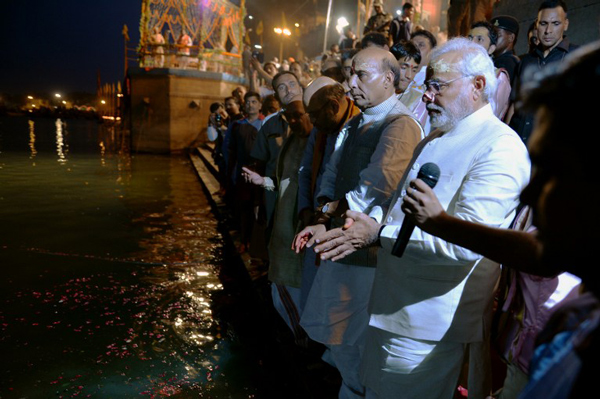Govt thinks corporatisation is the way to clean Ganga. Will it work?

Clean Ganga
- The govt has been talking of cleaning up the Ganga
- It has now turned to public-pvt partnerships
- Centre plans to turn National Mission for Clean Ganga into a company
More in the story
- Will corporatisation help in cleaning up Ganga?
- How has previous steps to clean up Ganga fared?
- Do we have enough information to act?
Public-private partnerships have been the buzz for quite some time. And now the government plans to introduce the model to clean up rivers.
Union Water Resources Secretary Shashi Shekhar recently said talks were underway to set up a company to implement river-cleaning projects. Details will be out early next month during the 'Ganga Manthan', which would involve public consultations and discussions among all stakeholders.
Also read - NGT slams Modi govt over Ganga pollution, says 'slogans contrary to actions'
The Centre also plans to register National Mission for Clean Ganga (NMCG) as a company that will be responsible for treating industrial waste and sewage flowing into the river.
Cleaning up the Ganga, a river considered holy in Hindu tradition, has been one of the emotive planks of the Narendra Modi government. Modi himself represents Varanasi, a city on the banks of Ganga considered to be a spiritual seat, in Lok Sabha.
'Corporates would be held accountable and be forced to invest in treatment plants'
Earlier this month, a special purpose vehicle was set up to hasten the cleaning of the river. Last month, the government sought to ban construction across the the river basin.
The National Green Tribunal (NGT), not happy with the government's functioning, directed the central government not to release funds for cleaning the river from Gomukh to Kanpur without its approval. The NGT said there was no data regarding on sewage and industrial discharge at the state level.
Ganga originates from Gomukh in Uttarakhand while Kanpur, downstream, is in neighbouring Uttar Pradesh.
What would this mean for Ganga?

Modi performs "Ganga Puja" with other senior BJP leaders in May 2014. Photo: AFP/ Manjunath Kiran
Many activists and those involved with the Clean Ganga mission consider corporatisation to be a regressive move, a step towards privatising the mission.
"The question of accountability vanishes with a PPP model. Information flow will be within the government and the private entity involved. There will be lack of transparency," said R Sridhar, managing trustee at Environics, an environmental not-for-profit.
A PPP model will make passing the buck easier as the government will be able to excuse itself by saying the company in question failed to deliver on its promises, Sridhar said.
'Those at the ground need to be roped in; there has to be clear distinction on who is accountable'
"Most corporates are in debt. Why will they be interested in being a part of a PPP model unless they can profit from it? The entire motive of the mission would be lost."
Sridhar pointed out to the failure of PPP in even highly lucrative sectors like infrastructure. According to a report, between 2007 and 2012, out of the $225 billion invested by the private sector in infrastructure - much of it through PPPs - projects worth only $70 billion was under way or complete.
BD Tripathi, founder and member of the National Ganga River Basin Authority of India (NGRBA), agrees. "Some positive steps are being taken by the government, like banning all construction around the river. But this step is definitely retrograde."
Tripathi argues that millions of rupees have already been spent, but with little impact. More than a change in model, what is required is to asses what went wrong with the previous attempts.
'Present data does not even distinguish between industrial pollutants and sewage pollutants'
The government spent more than Rs 20,000 crore on various clean-up projects, according to a 2012 Central Pollution Control Board report. But the result? "Ganga is more polluted now than it was five years ago," Tripathi pointed out.
The first attempt to clean the Ganga dates back to Rajiv Gandhi's Ganga Action Plan with a budget of Rs 1,700 crore. In 2004, that was declared a failure due to substandard monitoring mechanisms.
Also read - Here's what Modi is doing to clean the Ganga: a whole lot of nothing
In 2011, the World Bank sanctioned $1 billion, which was distributed between the NGRBA and state governments to implement schemes to keep a check on pollution levels and implement various clean-up project. The next year, the Union environment ministry commissioned a consortium of seven IITs to prepare a comprehensive River Basin Management Plan.
There still isn't relevant data to assess the river's pollutions levels though, Tripathi said.
"The PPP model, or any model will fail to fulfill its purpose as present data does not even distinguish between industrial pollutants and sewage pollutants. This is why the NGT took the stand to restrict disbursement of funds without a clear understanding of the source of pollution and how it's generated," Tripathi said.

Photo: PIB
Activists also assert the need for better monitoring, taking their cue from the failure of Rajiv Gandhi's plan.
"What is needed is a team at the ground level to monitor the implementation of all projects involved, with members having a limited period as part of the team. A sub-committee at the helm will not do justice," said Mallika Bhanot of Ganga Ahvaan, a people's movement to save the river.
'Most corporates are in debt. Why will they be interested unless they can make profit?'
The government has set up a committee, headed by the Transport Minister Nitin Gadkari and Water Resources Minister Uma Bharti along with Principal Secretary to PM Nripendra Misra as members, that would monitor the implementation of all projects.
According to Tripathi: "Those at the ground need to be roped in to the project in order for it to work, along with a clear distinction on who should be held accountable," he said.
Bhanot, however, said a PPP model would not necessarily spell doom. "With a transparent system in place and a clear monitoring mechanism it can work."
Vinay Tiwaree, of Ganga Mahasabha, agreed: "I believe it is a step in the right direction as corporates would be held accountable and be forced to invest in treatment plants and other ways to avoid direct discharge of industrial effluents."
More in Catch - This is one Ganga story you'll never forget. Everything you need to know about this holy mess
'Save Ganga' handed over to corporates: masterstroke or disaster?







![BJP's Kapil Mishra recreates Shankar Mahadevan’s ‘Breathless’ song to highlight Delhi pollution [WATCH] BJP's Kapil Mishra recreates Shankar Mahadevan’s ‘Breathless’ song to highlight Delhi pollution [WATCH]](https://images.catchnews.com/upload/2022/11/03/kapil-mishra_240884_300x172.png)

![Anupam Kher shares pictures of his toned body on 67th birthday [MUST SEE] Anupam Kher shares pictures of his toned body on 67th birthday [MUST SEE]](https://images.catchnews.com/upload/2022/03/07/Anupam_kher_231145_300x172.jpg)






